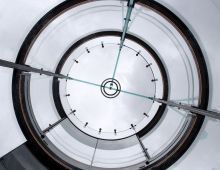Opening Mauritshuis
The extended and renovated Mauritshuis in The Hague is opened today by His Majesty King Willem-Alexander and Her Majesty Queen Máxima. For the entrance area Octatube has realised the fully glass elevator shaft and the floor lights.
The renewed Mauritshuis has been doubled in size by means of an underground extension towards a society building opposite the street. Yet little has changed to the character of the museum. The appearance and unique homely atmosphere are maintained by means of the design of Hans van Heeswijk Architecten.

Photography: Luuk Kramer
The most eye-catching change is the relocation of the main entrance to the forecourt. Visitors no longer access the building by means of the old service entrance, but they are able to use the stairs and elevator at the front of the museum. As a result, the fences in front of the museum are opened for the public. Then, one enters an illuminated underground foyer that connects two buildings. Inside the spacious underground entrance one can find ticketing, the wardrobe, an information desk and the new museum shop. By positioning the foyer underneath the forecourt, the streetscape remains intact. Octatube has realised the walkable floor lights that have a slip resistant screenprint and bring in a lot of daylight. From the foyer visitors can orientate themselves and either go to the historic building that holds the permanent collection or to the new wing.

Photography: Ronald Tilleman, Credits: Mauritshuis, The Hague
The only impact on the forecourt of the Mauritshuis is made by an eye-catching round glass elevator shaft that is at the same time very elegant and transparent. It brings visitors who prefer not to use the stairs in the underground foyer, to the entrance area of the museum. The innovate glass elevator is unequalled.

Photography: Luuk Kramer
Firstly, maximum transparency has been achieved by designing an elevator that is not supported by a steel supporting structure. What makes this round glass elevator so unique is the fact that the all-glass structure is situated in an exterior situation. Thus the weather elements need to be resisted. The self-supporting elevator shaft of the Mauritshuis is no less than 10 meters in height.
The cylinder is made of laminated heat strengthened hot bent glass, connected by horizontal stainless steel hoops. Vertical stabilization is ensured by three vertical glass fins connected at the top by a transom fin. The position of these glass fins is semi-inside the cylinder to create an abstract tubular appearance of the glass shaft being supported by bended glass units. Two of the three vertical glass fins act as the conducting rails of the sides of the glass elevator cage. The extreme high technical requirements of side tolerances (within 1 mm) of the elevator cage are met.

Photography: Jacqueline Knudsen, Credits: ArchitectuurNL
Finally, the horizontal round roof top glass panel of the glass shaft has a valve built in the glass panel to ventilate the overpressure in summer. In winter warm air from the building is introduced at the bottom of the shaft to prevent condensation.
The Mauritshuis is home to the very best of Dutch Golden Age painting. The compact, yet world-renowned collection, is situated in the heart of The Hague, right next to the government centre. Masterpieces such as Vermeer's Girl with a Pearl Earring, The Anatomy Lesson by Rembrandt, The Goldfinch by Fabritius and The Bull by Potter are on permanent display in the intimate rooms of this seventeenth-century monument. The refurbishment and extension of the Mauritshuis has been completed in approximately 2 years.

.jpg)
